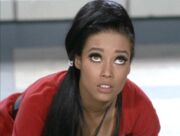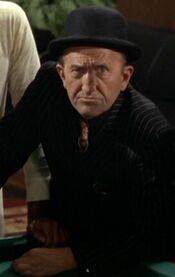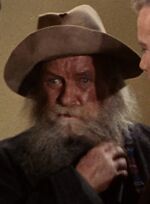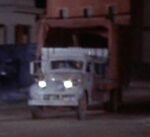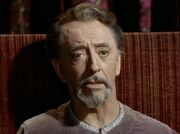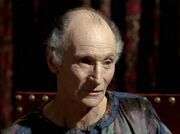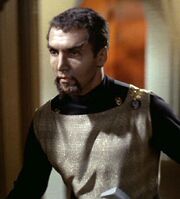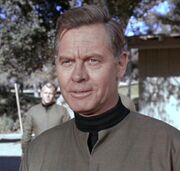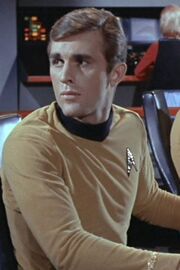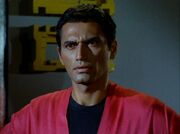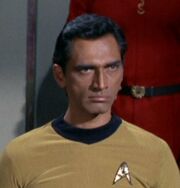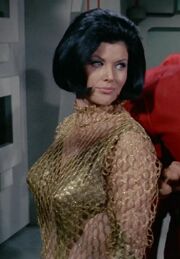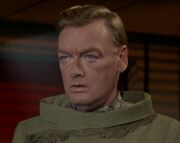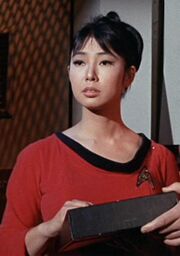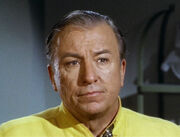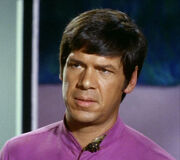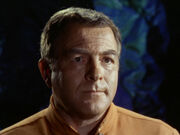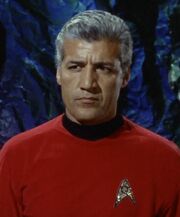You look at them, you want to look away. And the episode’s whole story is pretty much the crew members trying to dodge the things, which jerk thru the air at tight angles and in straight lines, making for a pervasive anti-plausibility. “Operation: Annihilate!” is a stinker like that one where the guest had a dreadful beard and the trippy optic effects were so painful. Looking at the screen becomes a mug’s game, and as a result I’m still not sure what happened in this episode except that it involved the things that made me want to look away: in this case, rubber pancakes of dog vomit that fly.
The vomit pancakes were designed by Wah Chang, who is spoken of highly by Inside Star Trek. I can’t sign on there. The pancakes, the Gorn (“Arena”), the yeti (“Galileo VII”), the yeti-plus-spines-plus-horn-plus-tail (Mogotu, I think–it was in “A Private Little War”): put them all together and you’ve got “oy.” I admit that the pancakes, at least, are heavily detailed and richly molded; otherwise they wouldn’t be so disgusting. But they look like objects, not specimens, so they’re not convincing. The Gorn and the rest also fail to convince, and on top of that they look like crap. I think Wah Chang’s big value was probably that he could do big projects fast (a man-size suit or a dozen vomit pancakes count as a big project) and they wouldn’t fall apart.
Mem Alpha says the planet exteriors were shot at the “headquarters of TRW in Redondo Beach, California (currently the Northrop Grumman Space Technology headquarters).” … First appearance of McCoy’s lab, and it’s got one of the people-holding sleep pods from “Space Seed.”
Actors: not a lot of them. Here’s Jim Kirk’s sister-in-law.
She tells them the horrible thing that happened to the earth colony, then dies with enough agony to have caused some local tv stations to trim the scene in syndication. (Possibly without intent of adding more commercials: I read that, at least in the ’70s, the stations showing Trek kept the episodes intact for fan acceptability. Instead it was a case of local papers assigning suitability grades to tv shows in their listings.)
The actress, Joan Swift, was born in Sacramento, no birth year given. Her credits appear to be concentrated in the ’60s and include The Jack Benny Program and The Andromeda Strain (1971). She did some other Desilu work: The Lucy Show, I Spy. Latest available credit is Lucy Gets Lucky, a Lucy Ball tv movie from 1975.
Girl redshirt: In the landing party when it gets attacked, but nothing happens to her. The actress was in a couple of movies and that was it. One was a Presley vehicle with a great title: Stay Away, Joe (1968).
Her redshirt’s last name is Jamal, which is part of a pretty steady background effort by old Trek to infiltrate the screen with non-white bread Enterprise hands. Actress’s name is great: Maurishka Taliaferro.
Man, is she pretty. Makeup isn’t my thing, but I’m guessing the look here is very ’60s and Twiggy-like — I mean the way the eyes are done up.
Afflicted stunt man, b. 1923 in Texas, did a lot of work from late 1940s on, retired in late 1970s. Here he’s just a member of the earth colony emoting because of the parasites:
Another of the planet guys. The actor had bits in the 1954 Star Is Born and Scorsese’s New York, New York. To me, looking at that photo, it’s a surprise that he was a bit player. He’s got regular features but a lived-in sort of face, a good combo for tv work, and his expression here looks like it’s got something going on.
Also emoting, a second stunt man (Jerry Catron, no birth year; credits seem okay but concentrated in 1960s):
The redshirt is also Catron and appeared in “Doomsday Machine” and “Journey to Babel,” which are second-season eps; “Annihilate” was the last ep made for the first season. For the record, Mem Alpha gives the redshirt’s name as Montgomery.



